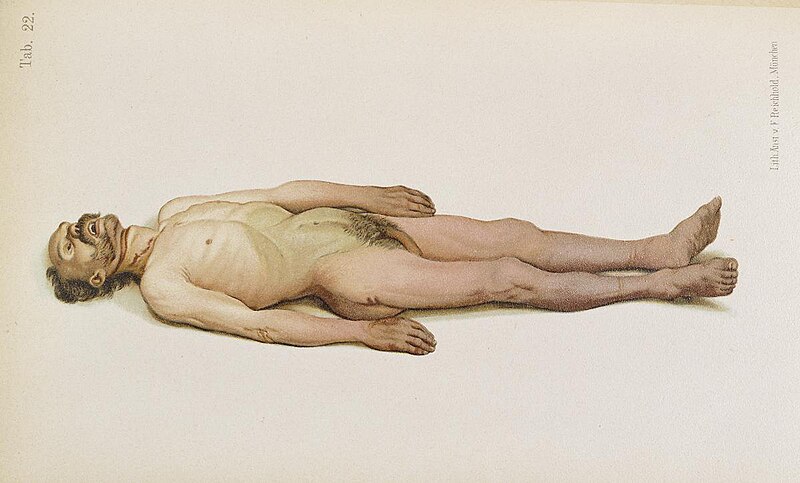File:Hofmann Lehrbuch suicide hanging.jpg

Original file (1,200 × 724 pixels, file size: 72 KB, MIME type: image/jpeg)
This file is from Wikimedia Commons and may be used by other projects. The description on its file description page there is shown below.
| DescriptionHofmann Lehrbuch suicide hanging.jpg |
Eduard Ritter von Hofmann (1837-1897): "Lehrbuch der gerichtlichen Medicin." Vienna, 1878. / taken from translation "Atlas of Legal Medicine", Philadelphia 1898. (from pp. 302-303-304) English: Plate 22: Suicide by hanging; suspension of the body for several days; peculiar distribution of the hypostases.
Italiano: Tavola 22: Suicidio per impiccagione; sospensione del corpo per diversi giorni; distribuzione peculiare dell’ipostasi cadaverica. |
|||
| Source | National Library of Medicine | |||
| Author | Chromolithograph by A. Schmitson | |||
| Permission (Reusing this file) |
Original work of the US Federal Government - public domain |
| Public domainPublic domainfalsefalse |
This work is in the public domain in the United States because it is a work prepared by an officer or employee of the United States Government as part of that person’s official duties under the terms of Title 17, Chapter 1, Section 105 of the US Code.
Note: This only applies to original works of the Federal Government and not to the work of any individual U.S. state, territory, commonwealth, county, municipality, or any other subdivision. This template also does not apply to postage stamp designs published by the United States Postal Service since 1978. (See § 313.6(C)(1) of Compendium of U.S. Copyright Office Practices). It also does not apply to certain US coins; see The US Mint Terms of Use.
|
 | |
| This file has been identified as being free of known restrictions under copyright law, including all related and neighboring rights. | ||
https://creativecommons.org/publicdomain/mark/1.0/PDMCreative Commons Public Domain Mark 1.0falsefalse
Captions
Items portrayed in this file
depicts
image/jpeg
File history
Click on a date/time to view the file as it appeared at that time.
| Date/Time | Thumbnail | Dimensions | User | Comment | |
|---|---|---|---|---|---|
| current | 14:54, 23 March 2008 |  | 1,200 × 724 (72 KB) | McLeod | {{Information |Description=Eduard Ritter von Hofmann (1837-1897): "Lehrbuch der gerichtlichen Medicin." Vienna, 1878. / taken from translation "Atlas of Legal Medicine", Philadelphia 1898. |Source=[http://www.nlm.nih.gov/ National Library of Medicine] |Da |
File usage
There are no pages that use this file.